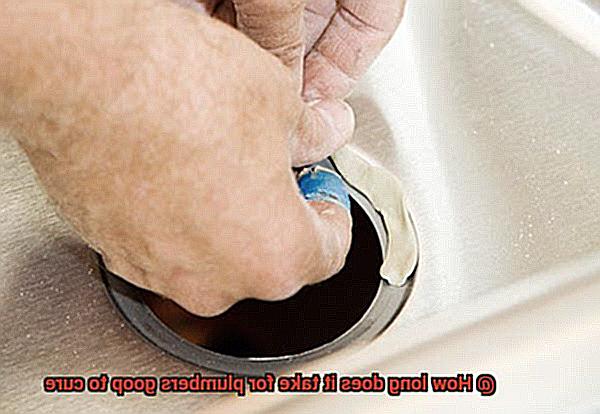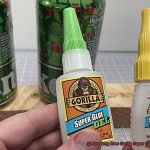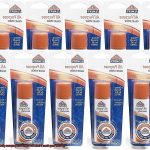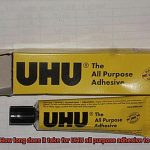If you’ve ever tackled a plumbing or household repair, you know finding the right adhesive is key for a solid and lasting fix. Plumber’s goop, loved by DIY enthusiasts and pros alike, boasts amazing bonding properties.
But here’s the deal: it needs time to cure properly. The curing time of plumber’s goop can vary depending on factors like temperature, humidity, and materials being bonded.
So hang tight as we unveil how long it takes for plumber’s goop to cure – knowledge every DIY enthusiast or pro plumber should have in their toolbox.
What is Plumbers Goop?
Contents
When it comes to plumbing repairs or construction projects, having a reliable adhesive that can create a strong and waterproof seal is essential. Plumbers Goop, a versatile adhesive commonly used in plumbing applications, fits the bill perfectly.
But what exactly is Plumbers Goop? In this article, we will explore the characteristics and applications of Plumbers Goop, as well as its curing time and factors that affect it.
Characteristics and Applications:
Plumbers Goop is a remarkable adhesive renowned for its exceptional bonding properties and ability to create a waterproof seal. This adhesive is specifically formulated for plumbing applications and excels at securing pipes, fittings, and other plumbing components with an airtight and leak-free seal. Its versatility extends to a wide range of materials, including metal, plastic, glass, ceramic, and wood. This makes Plumbers Goop the go-to choice for various plumbing projects where different surfaces need to be securely bonded together.
Curing Time and Factors Affecting It:
The curing time of Plumbers Goop can vary depending on several factors. Temperature and humidity are two significant factors that influence the curing process. Higher temperatures generally accelerate curing, while lower temperatures slow it down. Similarly, lower humidity levels can promote faster curing, while higher humidity levels may extend the curing time.
Application Thickness also plays a role in the curing time of Plumbers Goop. Thicker applications may require more time to cure completely compared to thinner ones. It is important to note that different brands and types of Plumbers Goop have varying compositions and formulations, resulting in different curing times. Therefore, it is crucial to refer to the manufacturer’s instructions for accurate information about the specific product you are using.
Recommended Curing Time:
In general, Plumbers Goop takes around 24 to 72 hours to fully cure. However, it is important to note that this is just an estimate, and the actual curing time may vary based on the factors mentioned above. To ensure optimal bond strength and performance, it is crucial to allow sufficient curing time for Plumbers Goop before subjecting it to any stress or pressure.
Fast-Curing Variants and Specialty Plumbers Goop:
For quick repairs or emergency situations, certain Plumbers Goop products are designed to have a faster curing time. These variants can cure within a few hours or even minutes, providing immediate results. On the other hand, specialty or high-strength Plumbers Goop may require a longer curing time to achieve maximum strength and durability. In some cases, it may take up to a week or more for these types of goops to fully cure.
Factors Affecting Curing Time
Unleashing the Power of Plumbers Goop: Factors That Affect Curing Time
Plumbers Goop, the superhero of adhesives in the plumbing world, possesses exceptional bonding powers and the ability to create an impenetrable seal. However, its curing time can vary depending on various factors. In this article, we will explore the key factors that affect the curing time of Plumbers Goop, providing you with valuable insights to achieve optimal results.
Different types of Plumbers Goop exist, each with its unique formulation. It is crucial to follow the manufacturer’s instructions and recommendations for optimal results. Choosing the right type of Plumbers Goop that matches your specific needs can also impact the curing time.
The surrounding temperature and humidity levels play a vital role in the curing time of Plumbers Goop. Higher temperatures accelerate the curing process, while lower temperatures slow it down. Similarly, high humidity can prolong curing time, whereas low humidity promotes faster curing.
The thickness of the Plumbers Goop layer applied also affects its curing time. Thicker layers take longer to cure compared to thinner ones. Applying an even and consistent layer of goop ensures uniform curing.
Proper ventilation is essential during the curing process as it facilitates the release of trapped air and allows moisture to evaporate, aiding in the curing process. Insufficient ventilation can result in prolonged curing times, while excessive ventilation may cause the goop to dry too quickly.
The material on which Plumbers Goop is applied can influence its curing time. Porous materials such as wood or concrete tend to absorb moisture from the goop, slowing down the curing process. Non-porous materials like metal or glass may not absorb moisture, leading to faster curing times.
The method used to apply Plumbers Goop can also impact its curing time. Thick beads or glob-like applications may take longer to cure compared to thin and even applications. Similarly, factors like pressure and technique used during application can affect how well the goop adheres and cures.
The chemical composition of Plumbers Goop can influence its curing time. Some goops may contain additives or accelerators that promote faster curing, while others may have a slower curing time due to their specific formulation. Understanding the product’s composition and any potential additives is crucial for successful application.
Quick-Curing Goops
In the fast-paced world of plumbing repairs and installations, time is of the essence. Enter quick-curing goops, the adhesive superheroes known for their lightning-fast bonding abilities. But before you dive into using these magic potions, it’s important to consider the pros and cons. In this blog post, we will explore the advantages and disadvantages of using quick-curing goops for plumbing repairs and installations.
Advantages:
- Faster Completion: Quick-curing goops excel at saving time. With their rapid curing properties, these adhesives allow you to complete plumbing projects much faster. This is especially beneficial when time is limited or when a quick repair is required.
- Enhanced Bonding Strength: Formulated with special additives, quick-curing goops offer more than just speed. These additives promote cross-linking of adhesive molecules, resulting in a faster and stronger bond. This ensures that your plumbing repairs and installations are secure and durable.
- Convenience: The quick-curing nature of these goops provides unparalleled convenience. You can swiftly move on to other tasks or areas that require attention. This is particularly advantageous when working in tight spaces or high-demand environments.
Disadvantages:
- Proper Curing Time: While quick-curing goops offer convenience, it’s crucial not to compromise on curing time. Rushing this process may result in weaker bonds or even adhesive failure. Always follow the manufacturer’s instructions regarding application, curing time, and any specific conditions required for optimal bonding.
- Material Considerations: Different materials have varying bonding requirements and may need additional time for full strength development. It’s essential to consider the nature of the materials being bonded when using quick-curing goops and ensure they are compatible with the adhesive.
- Surface Preparation: Properly preparing surfaces is crucial for optimal bonding. Quick-curing goops may not adhere well to dirty, oily, or uneven surfaces. Take the time to clean and prepare the surfaces properly before applying the adhesive to ensure a strong bond.
High-Strength Goops
Today, we embark on an exciting journey into the captivating realm of high-strength goops, where we will uncover the secrets behind their extraordinary powers. Our focus will be on the legendary plumbers goop, renowned for its Herculean strength and unwavering resilience in the face of water, chemicals, and extreme temperatures.
Unleashing the Power:
- The Formulation: Plumbers goop is a meticulously crafted blend of polymers and additives, harmoniously working together to create an adhesive with unparalleled bonding capabilities. This secret recipe ensures durability and longevity in a multitude of plumbing applications.
- The Mesmerizing Curing Process: Like a superhero undergoing a transformation, plumbers goop undergoes a mesmerizing chemical reaction during the curing process. This reaction, known as polymerization, causes the goop to metamorphose from a liquid or gel-like state into an unyielding solid, forming an invincible bond. However, patience is paramount here, as it takes anywhere from 24 to 72 hours for the adhesive to reach its full strength.
- Factors Influencing Curing Time: Temperature, humidity, and even the materials being bonded all have a role to play in the curing process. Higher temperatures and lower humidity levels expedite curing, while cooler temperatures and higher humidity levels slow it down. To achieve optimal results, it is imperative to adhere to the manufacturer’s instructions regarding curing time and conditions.
- The Waiting Game: Beware of illusions. Although plumbers goop may appear dry or partially cured within a few hours, do not be deceived. It is crucial to exercise patience and allow the adhesive to fully cure before subjecting it to stress or load-bearing activities. Remember – patience yields triumphant results in the end.
- Surface Preparation is Key: Just as a superhero requires a pristine canvas to save the day, surfaces must be meticulously cleaned, dried, and devoid of any contaminants or residues before applying plumbers goop. Thorough surface preparation guarantees maximum adhesion and strength, ensuring a bond that stands the test of time.
Armed with the knowledge of high-strength goops, particularly the mighty plumbers goop, you are now equipped to conquer any plumbing project with unwavering confidence.
Remember to follow the manufacturer’s instructions diligently, exercise patience during the curing process, and prepare surfaces meticulously for optimal results.
With plumbers goop as your faithful sidekick, you are ready to forge bonds that will withstand the trials of time.

Manufacturer’s Instructions
Manufacturer’s instructions are essential guidelines provided by the company that produces a product, such as plumbers goop. These instructions serve as a roadmap to unlock the full potential of this high-strength adhesive, ensuring optimal results in plumbing projects.
By following these instructions diligently, you can harness the extraordinary powers of plumbers goop and forge bonds that withstand the trials of time.
Curing Time: Embracing the Science
The manufacturer’s instructions provide valuable insights into the curing time of plumbers goop. Extensive testing and research have determined the optimal timeframe for proper curing, considering factors like temperature, humidity, and material types.
Deviating from these instructions may lead to weak bond strength or improper curing. Patience is key here, as the full curing process can take anywhere from 24 to 72 hours.
Application Methods: Mastering the Art of Bonding
The manufacturer’s instructions offer recommendations on application methods tailored specifically for plumbers goop. By following these instructions, you ensure correct and even application of the adhesive, maximizing its bonding capabilities. Additionally, surface preparation guidelines may be included to ensure optimum adhesion.
Safety Precautions: Your Shield Against Mishaps
Manufacturer’s instructions often include safety precautions to be followed during application and curing processes. These precautions protect both you and the materials being bonded. Familiarizing yourself with these guidelines ensures a safe working environment, guarding against mishaps.
Material Compatibility: Bonding with Confidence
Different materials require different adhesive properties for successful bonding. The manufacturer’s instructions provide valuable information on the compatibility of plumbers goop with various materials. By following these guidelines, you can confidently choose this adhesive for specific applications, knowing it will bond effectively.
Temperature and Humidity
Today, we’re diving into the captivating world of plumbers goop and uncovering the secrets of how temperature and humidity influence its curing time. Have you ever wondered why your goop took longer than expected to dry or why it didn’t bond as strongly as you hoped? Well, get ready to have your questions answered as we explore the fascinating relationship between temperature, humidity, and this adhesive’s behavior.
Let’s start with temperature. Just like Goldilocks and her porridge, plumbers goop prefers it not too hot, not too cold, but just right. The ideal temperature range for curing is typically between 60°F and 90°F (15°C and 32°C). When it’s too chilly, your goop might throw a tantrum and take forever to harden. On the other hand, if things get too steamy, your goop might rush through the curing process, resulting in a weaker bond. So, finding that sweet spot is crucial for optimal performance.
But wait, there’s more. Humidity levels also play a role in the goop’s curing game. High humidity can be the goop’s worst enemy, slowing down the drying process and leaving you waiting for what feels like an eternity. Moisture in the air interferes with the chemical reactions responsible for curing. On the flip side, low humidity levels can speed things up and have your goop ready for action in no time.
Now that we’ve covered the basics, let’s not forget about other factors that can influence curing time. The thickness of your goop layer matters – thicker applications will take longer to cure compared to thin coats. Different surfaces may have different absorption rates, so porous materials might guzzle up moisture from the goop, affecting its drying time. And watch out for any pesky contaminants lurking around – they can throw a wrench in the curing process too.
To ensure a successful bonding experience with your plumbers goop, always consult the manufacturer’s instructions for specific temperature and humidity recommendations. Don’t be afraid to whip out your trusty thermometer and hygrometer to measure the conditions accurately – the goop will thank you for it.
So, whether you’re tackling a plumbing project or embarking on a creative endeavor, remember that temperature and humidity are the goop’s best friends when it comes to curing time. Keep them in check, follow the instructions, and watch your adhesive dreams come true.
Allowing Adequate Curing Time
If you’ve ventured here, you’re likely seeking the secrets to maximizing the potential of this remarkable adhesive. One crucial aspect that should never be overlooked is granting plumbers goop the necessary time to cure properly. In this article, we will delve into the reasons why allowing adequate curing time is essential for achieving a robust and enduring bond.
The Science Behind Curing:
Plumbers goop is no ordinary glue; it is engineered specifically for plumbing applications where durability reigns supreme. Curing is the transformative process by which the adhesive metamorphoses from a liquid state to a solid, forging a dependable seal between materials. Let us now explore why it is paramount to bestow upon plumbers goop the time it deserves to work its magic.
Factors Influencing Curing Time:
Several factors can influence the curing time, including temperature, humidity, adhesive thickness, and the materials being bonded. Understanding these variables is critical for achieving optimal results.
Temperature and Humidity: The Goldilocks Effect:
Similar to Goldilocks and her quest for the perfect porridge, plumbers goop craves ideal temperature and humidity conditions. Extreme temperatures induce tantrums – excessive heat rushes the curing process, resulting in weaker bonds, while extreme cold slows it down, compromising effectiveness. Discovering that sweet spot is paramount for successful adhesion.
Thickness Matters:
Thicker applications of plumbers goop necessitate longer curing times. Moreover, porous or challenging-to-bond materials may also demand extended periods for proper curing. Adhering to manufacturer’s instructions and considering these factors will ensure a tenacious bond.
Preparing for Success:
Prudent surface preparation is vital for effective bonding. Eliminating dirt, grease, and remnants of old adhesive guarantees an immaculate canvas for plumbers goop to unleash its powers. Remember, a pristine surface is a jubilant surface.
Applying the Right Amount:
To achieve a robust bond, applying the optimal amount of plumbers goop is paramount. Insufficient adhesive may result in feeble adhesion, while excessive application can lead to unsightly squeeze-out. Striking the perfect balance will yield the best outcomes.
Patience is Key:
Following the application of plumbers goop, employing clamps or securing methods to hold the bonded surfaces in place during the curing process is highly recommended. This prevents any motion that could jeopardize the bond and ensures precise alignment.
Test Before Trusting:
Before subjecting the bonded surfaces to stress or pressure, it is vital to test the strength of the bond. Gently applying force or pulling on the surfaces will provide peace of mind, knowing that everything is securely held together.
Hardening and Strengthening Over Time
Look no further than plumbers goop, the magical adhesive sealant that works wonders in your plumbing projects. But have you ever wondered how this goop manages to harden and strengthen over time? Let’s dive into the science behind it and uncover the secrets to its success.
Curing is the name of the game when it comes to plumbers goop. This process involves a remarkable transformation from a liquid or semi-liquid state to a solid one. During curing, powerful chemical reactions take place, forming cross-linked polymer chains that give the goop its mighty strength and durability.
But here’s the fascinating part – curing time isn’t set in stone. It varies depending on factors like temperature, humidity, and even the thickness of the applied layer. In ideal conditions, where it’s around 70°F (21°C) with low humidity, the goop usually cures within 24 hours. However, if it’s hotter or colder, or if the humidity is high, a little more patience may be required.
Don’t let appearances fool you. Even if plumbers goop seems dry and solid after just a few hours, it may not have fully cured yet. To ensure optimal strength and durability, it’s best to wait at least 24 hours before subjecting the cured area to any stress or load. Trust me, good things come to those who wait.
And here’s another fascinating tidbit – plumbers goop continues to harden and strengthen over time. Even after the initial curing period, this adhesive keeps evolving, gradually developing its full potential. So don’t rush it. Allow sufficient time for your beloved goop to reach its maximum strength before exposing it to water, pressure, or any other stressors.
Ein1DC-QnO8″ >
Conclusion
Plumbers goop, a handy adhesive used in plumbing repairs, is known for its quick curing time. But just how long does it take for this magical substance to fully cure? Well, the answer may surprise you. In most cases, plumbers goop can cure within 24 hours. Yes, you heard that right – just one day. Imagine being able to fix that leaky pipe or seal that stubborn joint in such a short amount of time.
But wait, there’s more. Plumbers goop doesn’t just cure quickly; it also forms an incredibly strong bond once fully cured. This means you can have peace of mind knowing that your plumbing repair will stand the test of time. No more worrying about leaks or drips causing havoc in your home.
So, why choose plumbers goop over other adhesives? Well, besides its speedy curing time and exceptional strength, plumbers goop also boasts excellent resistance to water and chemicals. This makes it perfect for use in wet environments like bathrooms or kitchens where moisture and various substances are present.
But remember, patience is key when working with plumbers goop. While it may cure within 24 hours, it’s best to give it some extra time to ensure optimal results. So sit back, relax, and let plumbers goop work its magic.
In conclusion, if you’re looking for a reliable adhesive with a quick curing time and unmatched strength, look no further than plumbers goop. Its ability to bond quickly and withstand the toughest conditions makes it an essential tool for any plumbing repair job.






